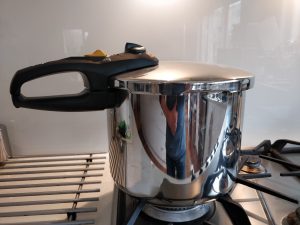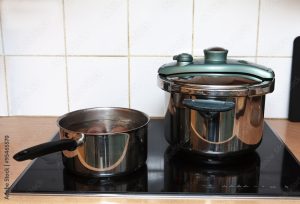Are you worried about how to open a pressure cooker that is stuck? It’s not unusual for your pressure cooker lid to get stuck occasionally. Whether you’re using a classic stovetop model or a modern electric multi-cooker, I know how important it is for your pressure cooker to have a tight-sealing lid in order to function properly.
Breaking that seal can sometimes be challenging. But don’t worry, I’m here to assist you in understanding the reasons behind this issue and finding effective solutions.
There are a few common factors that can cause the lid to get stuck, and I can provide you with a handful of practical ways to solve the problem.
How to Open a Pressure Cooker that is Stuck: To open a stuck pressure cooker, pour cold water on it to release the pressure. If that fails, remove the pressure valve and heat the cooker gently on the stove, following safety guidelines.
Quick Navigation
How to Open a Pressure Cooker that Is Stuck?
If you’re having trouble opening a stuck pressure cooker, don’t panic. There are a few simple steps you can take to resolve the issue. First, make sure to turn off the heat and let the pressure cooker cool down.
This will allow any remaining steam to be released naturally. Once it’s cooled down, follow the steps below to safely open the pressure cooker and continue cooking without any problems.
Taking the Pressure Cooker Off the Heat Source:
If your pressure cooker is stuck, the very first thing you need to do is remove it from the heat source. This is important for safety reasons and to prevent any additional pressure from building up.
By taking it off the heat, you allow the pressure to naturally release on its own, making it safer to open the cooker later on.
Using a Towel as a Cover for the Pressure Cooker:
After taking the pressure cooker off the heat, place a towel on top of it. This will absorb any remaining steam and prevent it from rushing out when you open the cooker.
Additionally, wearing oven mitts or using pot holders to securely hold the pressure cooker will ensure it stays in place while you work with it.
Releasing All Pressure from the Pressure Cooker:
To release pressure from the pot, use the pressure release valve if available. If not, open the lid slightly, being cautious of hot steam and remaining pressure. Exercise caution to avoid burns.

Once all the pressure has been released, it’s time to open the pressure cooker lid. Be careful of the hot steam that may still be inside. To protect your hands, use a kitchen towel while opening the lid.
If the lid is stuck, apply gentle pressure around the edges while trying to open it simultaneously. For stovetop pressure cookers, place the stuck lid in the sink and run cold water over it to loosen it.
With electric pressure cookers, gently tap the edges and press down on the lid while opening. If these methods fail, close the valves and put the cooker back on the stove to build pressure, which can help loosen the lid.
If all else fails, use a can opener on the lid, but only when the pressure is low and the cooker is not on the stove.
After opening, remember to clean the pressure cooker thoroughly. Proper understanding and handling of pressure cookers are vital as they can be dangerous if misused.
When the Float Valve Hasn’t Dropped
At the top of the pressure cooker’s lid, there’s a small metal pin called the float valve. When the cooker is pressurized, the float valve rises, and when it’s depressurized, it drops. If the float valve is up, you won’t be able to open the cooker.
While the float valve indicates the pressure inside the cooker, it can sometimes get stuck, preventing you from opening the lid.
If you’ve waited for a long time and the cooker hasn’t been heated or pressurized for a few hours, you can assume the pressure has been released and the float valve is stuck. Here’s how to fix it:
- Gently poke or tap the float valve using a non-sharp object. This should make the float valve drop.
- Open the pressure cooker once the float valve has dropped.
- Most likely, the food you cooked may have caused the float valve to become stuck. Make sure to thoroughly clean the pressure cooker before using it again.
Sticky Silicone Ring on the Lid
The silicone ring around the rim of the pressure cooker can become sticky due to exposure to various foods and temperatures over time. If your float valve has dropped but you’re still having trouble opening the lid, it may be stuck to the silicone ring.
Opening a pressure cooker lid that’s stuck to the silicone ring is a simple task. Follow these steps:
Gently but firmly twist the lid back and forth to separate it from the sticky silicone ring.
Clean the silicone ring by washing it in the dishwasher or sink to keep it free from residue.
Before attempting to twist the lid, make sure that the float valve has dropped.
Never try to force open a pressurized cooker, as it can be extremely dangerous. It’s nearly impossible to open a pressurized cooker, and I strongly advise against attempting it for your own safety.
Essential Safety Checks
Prioritize safety when dealing with a pressure cooker. Never force open a pressurized cooker. Look for the float valve on the lid, which drops when the pressure reaches zero. Try pouring cold water to release pressure or heat the cooker on the stove if necessary.
However, always prioritize safety and follow the manufacturer’s instructions when dealing with a stuck pressure cooker.
Allowing Pressure to Release Internally
It’s possible that your lid isn’t actually stuck, but rather the pressure cooker still has pressure inside, making it impossible to open. Opening a pressurized cooker can cause hot water to spray in all directions, which can result in burns.
It takes around 10 to 15 minutes for the pressure to naturally release. While the pressure is released, the food inside the cooker continues to cook, which can be beneficial for dishes like chili, pork, and ribs.
Using Penetrating Oil and Impact to Open the Pressure Cooker
Consider this as a last resort when all other methods have failed to open your stuck pressure cooker. While not an ideal solution, it’s important to note that this method can potentially damage the gasket.
Pay close attention to how you separate the lid from the rim, as it may require some careful maneuvering. Keep in mind that if you end up damaging the sealing ring, you may need to purchase a replacement.
Additional Tips
Here are some additional tips for opening a pressure cooker that is stuck:
To avoid the pressure cooker getting stuck in the future, follow these tips:
- Properly Position the Sealing Ring: Before each use, ensure the sealing ring is clean and properly positioned. This ensures a tight seal and prevents any potential leakage or sticking.
- Don’t Overfill the Pressure Cooker: Avoid exceeding the recommended maximum capacity of the pressure cooker. Overfilling can lead to blockages, difficulty in building and releasing pressure, and potential damage to the cooker.
- Clean the Pressure Release Valve: Regularly clean the pressure release valve to prevent any clogs or blockages. This ensures that pressure is released smoothly and helps prevent the valve from getting stuck.
- Lubricate the Sealing Ring: Apply a small amount of cooking oil or non-stick cooking spray to the sealing ring to keep it properly lubricated. This can help reduce friction and make it easier to open and close the pressure cooker.
- Handle the Lid with Care: Avoid forcefully closing the pressure cooker lid. Ensure it aligns properly with the cooker’s base before sealing. Applying excessive force can cause misalignment and lead to a stuck lid.
Regular maintenance and cleaning of the pressure cooker are crucial for its longevity and optimal performance:
- Thorough Cleaning After Each Use: Clean the pressure cooker thoroughly after each use according to the manufacturer’s instructions. Pay special attention to removing any food residue or buildup from the cooking pot, lid, and sealing ring.
- Clean and Inspect the Sealing Ring: Regularly remove and clean the sealing ring. This helps prevent odors and ensures a proper seal. Inspect the ring for any signs of wear or damage and replace it if necessary.
- Check and Clean the Pressure Release Valve: Regularly check the pressure release valve and clean it to prevent any debris or residue from blocking the valve’s functionality. Follow the manufacturer’s instructions for disassembling and cleaning the valve.
- Inspect and Clean the Vent Pipe or Steam Vent: Periodically inspect the vent pipe or steam vent to ensure it’s clear of any obstructions. Clean it gently using a brush or pipe cleaner, if needed, to maintain proper pressure release.
If you encounter persistent issues or are unable to solve a problem with your pressure cooker, it’s advisable to seek professional help:
If you’ve tried various troubleshooting methods and the issue persists, or if you’re unsure about attempting any repairs yourself, it’s best to contact the manufacturer’s customer support or consult a professional appliance repair service.
They can provide expert guidance, identify any underlying issues, and ensure the safety and proper functioning of your pressure cooker.
Safety Precautions
Here are some safety precautions to consider when dealing with a stuck pressure cooker:
Safety when Handling a Pressure Cooker:
- Read and understand the instructions provided by the manufacturer.
- Handle the pressure cooker with caution, especially when it’s hot or under pressure.
- Fully release the pressure before opening the cooker to prevent burns or accidents.
- Use only recommended accessories to maintain safety.
- Keep children and pets away from the pressure cooker during use and cooling.
- Ensure proper ventilation in the cooking area to disperse heat and steam.
Safety Gear Required:
- Use heat-resistant gloves or mitts to protect your hands and forearms.
- Wear safety goggles to shield your eyes from steam or hot liquid.
- Consider wearing an apron or protective clothing to avoid spills or splatters.
- Utilize long-handled utensils to keep hands away from hot steam.
- Place trivets or heat-resistant mats to protect surfaces from heat damage.
Remember, to prioritize safety when handling a pressure cooker by following instructions, using recommended safety gear, and practicing caution throughout the cooking process.
FAQs:
Q:1 Why is the lid of my pressure cooker, not opening?
Check the float valve (pressure valve) near the release valve. If it’s up, push it down. The button must be down for the lid to open or close. If that doesn’t work, ensure the seal is in the correct position.
Q:2 What could be causing my pressure cooker to be stuck in the “on” position?
Possible reason: The Instant Pot displaying ‘On’ could be due to a delay between the float valve rising and the timer starting, which can happen when using less liquid than recommended.
Q:3 Is it possible to cook in a pressure cooker with the lid open?
Yes, it is possible to cook in an Instant Pot with the lid open. Certain modes, like sautéing, allow cooking without the lid to achieve browning and crispness as the lid doesn’t trap in steam.
Conclusion:
In conclusion, opening a stuck pressure cooker requires careful steps to ensure safety and successful release. Begin by removing the pressure cooker from the heat source and allowing the remaining steam to release naturally.
If the lid remains stuck, attempt pouring cold water over the cooker or gently tapping the edges to loosen it. If these methods don’t work, consider removing the pressure valve and heating the cooker on the stove.
It’s crucial to prioritize safety, follow the manufacturer’s instructions, and avoid attempting to open a pressurized cooker. If all else fails, seek professional assistance. Remember to clean the pressure cooker thoroughly before future use for optimal performance.
We hope you will be well aware of how to open a pressure cooker that is stuck, after reading this comprehensive article. If you have any questions, feel free to comment below!



